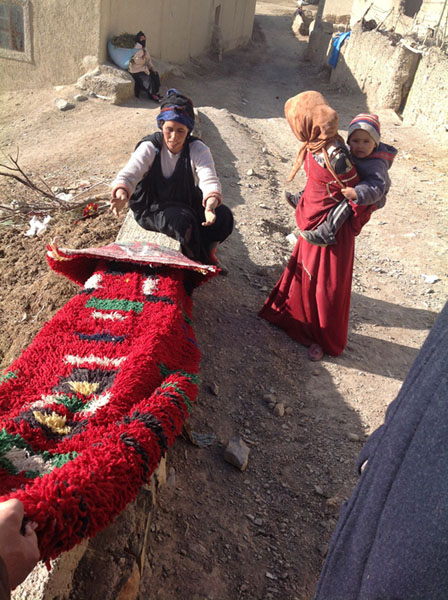Buying Trip to Source Original Berber Carpets
Mohammed (one half of Maroc Tribal) has been in Morocco since February, journeying into the Middle and High Atlas mountains to talk with villagers and family weavers, to buy the best and most beautiful vintage rural Berber carpets he can find. While he has been away (and we have a hoard of treasures to bring back!) we've been considering how hard it is to find truly original old carpets, those made just for personal and domestic use by the different ethnic groups, mainly Berber, most of whom were semi-nomadic. Berber carpets have an ancient history, and they have remained authentic expressions of a creative tradition until recently. However, with the growth of global attention on Moroccan carpets, many low quality reproductions now abound, produced for sale and export, and many shops and dealers in Morocco, particularly in the tourist centres of Marrakech, Essaouira and Tangiers, promote these new carpets as 'vintage'.
Buying a bright carpet from a women in the Middle Atlas mountains
As original carpets were not traded or collected in Europe in earlier periods, until the 1950s they were mostly only known and used in the places they were woven. Old pieces that no longer fulfilled their function were rarely preserved, so in reality there is a limited supply of original old pieces in Morocco, and many of the museum quality pieces are now in private or public collections. There are not many excellent examples from before the 1940s.
A clandestine 'factory' producing and aging new carpets so they can be sold as old. Harsh chemicals harm the wool
This makes our job both exciting and challenging! We champion genuine rural Moroccan carpets; those which have retained their authenticity. Mohammed, who speaks the Berber language as well as Arabic, spends two to three months a year deep in Berber territory, buying direct from weavers and at little markets. He travels all through the different regions to buy fine examples from different tribes. Originally the way in which these carpets were woven made them easily adaptable to any climate: in the mountain climates, they are woven with a high pile and are more loosely knotted and give protection against the cold, whereas in warmer places a lower pile and a finer weave is used as carpets are mainly for sitting and floor coverings. Working this way he can also buy direct from the women who wove the carpets, or their families, and pay them the very best price; making sure it goes direct to them and does not pass through an intermediary, who pay these families very little.
Boucherouite rugs hanging out to air. We often see a lovely carpet in someone's garden!
During this trip we’ve been able to find some gorgeous carpets, klims and textiles. We’ve even been able to source some very large ‘master woven’ carpets, some up to 5 meters long: these were often made for wealthy families and were regarded as extremely prestigious and served as examples and source of inspiration for other weavers. We have a super collection of cream and brown Beni Ouarain carpets, some very old, some more contemporary, and some graphic and bold, seemingly abstract carpets from the Azilal region.
Women coming to a market in the High Atlas mountains, wearing handowven shawls
We will be unveiling the new collection on the website later on in April, and we will be in touch when the new pieces are online.




